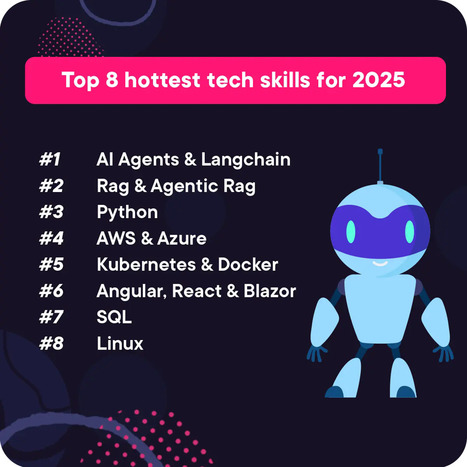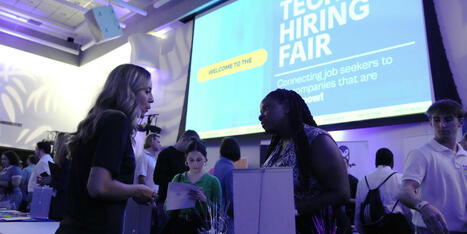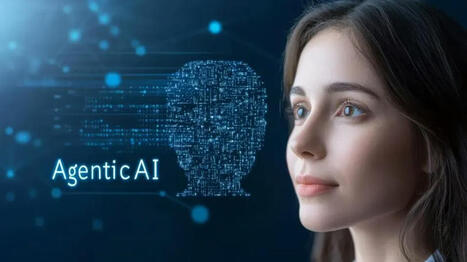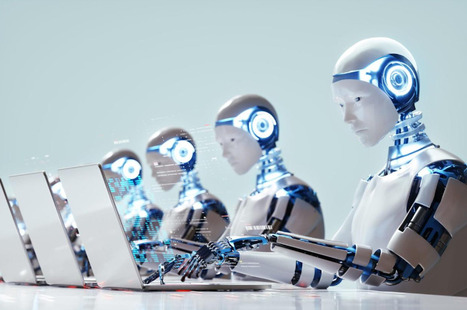 Your new post is loading...

|
Scooped by
Edumorfosis
May 10, 7:59 AM
|
Generative AI (GenAI) continues to evolve, with new use cases and applications emerging regularly. A year after my initial research, it’s clear that while technical uses remain prominent, there has been a significant shift toward more personal and emotional applications. In particular, “Therapy / companionship” has emerged as the top use case, with many users turning to AI for emotional support, grief processing, and self-reflection. The non-judgmental, always-available nature of these interactions has made AI an essential tool for mental and emotional well-being.
Alongside this, new use cases like “Organize my life” and “Find purpose” reflect an increasing demand for AI to help with personal growth and goal-setting. These examples highlight how AI is being used not just for productivity but for self-improvement, offering a more holistic role in people’s lives.
While emotional and personal support has risen in importance, professional applications like “Generate code” and “Enhance learning” have also gained traction, underscoring GenAI’s role in transforming work and education. However, some categories, such as “Generate ideas” and “Fun & nonsense,” have seen declines, signaling a shift toward more meaningful and practical uses of AI.
As users become more familiar with the technology, there’s growing awareness of both its potential and its limitations. While AI is empowering users to learn, solve problems, and enhance their work, concerns about dependency and data privacy remain, particularly as AI’s capabilities continue to expand.

|
Scooped by
Edumorfosis
May 10, 7:32 AM
|
Artificial Intelligence does not change anything about the fundamental nature of sustained competitive advantage when its use is pervasive. Once AI’s use is ubiquitous, it will transform economies and lift markets as a whole, but it will not uniquely benefit any single company. Businesses seeking to gain an innovation edge over rivals will need to focus their efforts on cultivating creativity among their employees.

|
Scooped by
Edumorfosis
May 8, 9:58 AM
|
From bank tellers and retail workers to software engineers and doctors, no line of work or type of business is entirely immune to artificial intelligence.
Despite AI’s potential to save employers on labor costs, increase productivity and spur overall economic growth, it can also lead to the disruption or loss of millions of jobs throughout the next several years.
In fact, the World Economic Forum (WEF) estimates that approximately 83 million jobs could be automated worldwide by 2027. The recent WEF study surveyed more than 800 companies, which employ 11.3 million workers across 45 countries, to gauge the fastest-growing and fastest-declining jobs. Meanwhile, Goldman Sachs places the estimated number of job losses even higher at 300 million jobs.

|
Scooped by
Edumorfosis
May 6, 9:20 AM
|
Artificial Intelligence has arrived in the workplace and has the potential to be as transformative as the steam engine was to the 19th-century Industrial Revolution.1 With powerful and capable large language models (LLMs) developed by Anthropic, Cohere, Google, Meta, Mistral, OpenAI, and others, we have entered a new information technology era. McKinsey research sizes the long-term AI opportunity at $4.4 trillion in added productivity growth potential from corporate use cases.2
Therein lies the challenge: the long-term potential of AI is great, but the short-term returns are unclear. Over the next three years, 92 percent of companies plan to increase their AI investments. But while nearly all companies are investing in AI, only 1 percent of leaders call their companies “mature” on the deployment spectrum, meaning that AI is fully integrated into workflows and drives substantial business outcomes. The big question is how business leaders can deploy capital and steer their organizations closer to AI maturity.

|
Scooped by
Edumorfosis
May 5, 10:08 AM
|
Upskilling is part and parcel with being in tech, but it can be tough to know where to spend your efforts. That's why we've done research into the top tech talents you might want on your CV in 2025, how you can test your current aptitude in these areas, and what learning resources are available to help you increase your knowledge.

|
Scooped by
Edumorfosis
May 2, 11:57 AM
|
Two years ago, prompt engineering was one of the buzziest jobs in tech, fetching salaries of up to $200,000 on the promise of becoming any company’s “AI Whisperer.”
Now, the role is basically obsolete thanks to the breakneck speed of AI development and companies’ own maturity in terms of understanding how to use the technology.
The concept of Prompt Engineers was to have an expert crafting the exact right inputs to generate the best responses out of large language models. But today, AI models are much better at intuiting user intent and they can ask follow-up questions when they’re unclear on it.

|
Scooped by
Edumorfosis
April 27, 10:41 PM
|
At Stanford HAI, we believe AI is poised to be the most transformative technology of the 21st century. But its benefits won’t be evenly distributed unless we guide its development thoughtfully. The AI Index offers one of the most comprehensive, data-driven views of artificial intelligence. Recognized as a trusted resource by global media, governments, and leading companies, the AI Index equips policymakers, business leaders, and the public with rigorous, objective insights into AI’s technical progress, economic influence, and societal impact.

|
Scooped by
Edumorfosis
April 14, 5:55 PM
|
La Organización de las Naciones Unidas (ONU) Comercio y Desarrollo advirtió a través de un nuevo informa que así como la Inteligencia Artificial (IA) está transformando las economías y creando oportunidades, también plantea riesgos de desigualdad como afectaciones al 40% de los puestos de trabajo en todo el mundo.

|
Scooped by
Edumorfosis
April 7, 9:20 AM
|
El estudio fue realizado por investigadores de la Universidad Carnegie Mellon y Microsoft Research. El estudio examina cómo las herramientas de IA Generativa afectan el pensamiento crítico de los profesionales.
Los investigadores: - Encuestaron a 319 trabajadores del conocimiento que utilizan herramientas de IA generativa (como ChatGPT, Copilot, etc.) en su trabajo al menos una vez por semana.
- Recopilaron 936 ejemplos reales de tareas realizadas con IA Generativa.
- Utilizaron la taxonomía de Bloom como marco para evaluar las actividades cognitivas asociadas al pensamiento crítico
- Combinaron análisis cuantitativo (modelos de regresión) y cualitativo (codificación de respuestas de texto libre).
Hallazgos: 1. Confianza y pensamiento crítico - Mayor confianza en la IA = Menos pensamiento crítico: Los trabajadores que confían mucho en la capacidad de la IA generativa tienden a aplicar menos pensamiento crítico y perciben que requiere menos esfuerzo pensar críticamente cuando usan estas herramientas.
- Mayor autoconfianza = Más pensamiento crítico: Por el contrario, quienes tienen mayor confianza en sus propias habilidades tienden a aplicar más pensamiento crítico, aunque perciban que requiere mayor esfuerzo.
2. Cambios en el esfuerzo cognitivo El estudio reveló un cambio en el tipo de esfuerzo cognitivo que realizan los profesionales: - De producción a supervisión: Los usuarios pasan de ejecutar directamente las tareas a supervisar y dirigir el trabajo de la IA.
- De recopilación de información a verificación: En lugar de buscar información, los usuarios ahora dedican esfuerzo a verificar la precisión de lo generado por la IA.
- De resolución de problemas a integración de respuestas: Menos esfuerzo en resolver problemas directamente, más en adaptar y contextualizar las soluciones proporcionadas por la IA.
3. Motivadores e inhibidores del pensamiento crítico Motivadores: - Calidad del trabajo: Los profesionales aplican pensamiento crítico para mejorar la calidad de sus resultados.
- Evitar resultados negativos: El deseo de prevenir errores o consecuencias negativas.
- Desarrollo de habilidades: Algunos usuarios aplican pensamiento crítico como forma de seguir aprendiendo.
Inhibidores: - Problemas de conciencia: Muchos usuarios no consideran necesario el pensamiento crítico para tareas percibidas como secundarias o triviales.
- Problemas de motivación: Falta de tiempo o percepción de que el pensamiento crítico no forma parte de sus responsabilidades laborales.
- Problemas de capacidad: Dificultad para verificar o mejorar las respuestas de la IA, especialmente en dominios desconocidos.

|
Scooped by
Edumorfosis
April 5, 3:53 PM
|
The International Monetary Fund warned that nearly 40% of jobs across the globe could be affected by the rise of artificial intelligence, with high-income economies facing greater risks than emerging markets and low-income countries.
The Washington, D.C.-based institution on Sunday assessed the potential impact of AI on the global labor market and found that, in most cases, the technology is likely to worsen overall inequality.

|
Scooped by
Edumorfosis
March 30, 12:05 PM
|
Artificial intelligence, automation, and digital connectivity are fundamentally reshaping how work is organized. Despite this, corporate workplaces, due to how they’re structured, are struggling to keep up.
According to EY, the average lifespan of an S&P 500 company has plummeted from over 65 years in the 1940s to just 15 years today. The speed of technological progress is outpacing the adaptability of our work systems, many of which are designed for a slower and more predictable era. Businesses that once thrived on longevity and stability must now embrace agility, continuous learning, and dynamic workforce models.

|
Scooped by
Edumorfosis
March 30, 10:56 AM
|
Agentic AI refers to AI systems built around the same language processing capabilities as services like ChatGPT but capable of carrying out much more complex, goal-oriented tasks with minimal human intervention. For example, they can interact with websites, fill out forms, collect and submit information and make payments.

|
Scooped by
Edumorfosis
March 25, 4:06 PM
|
- The balance of current economic indicators suggests continued labor market resilience in 2025.
- An economic soft landing is coming into view, but sticking it will require careful navigating around emerging headwinds, including a slowdown in hiring and looming labor shortages.
- Slowing labor force growth, an aging population, and an expected decline in immigration suggest that the supply of workers will weigh heavily on the job market in the coming years.
- Posted wage growth has leveled off at a healthy pace, suggesting continued robust competition for workers next year — especially in low-wage and in-person roles.
- Widespread use of GenAI tools promises to boost productivity, but adoption will need to spread beyond a handful of power-using sectors (including software development and mathematics) for the tools’ full productivity-boosting potential to be realized.
|

|
Scooped by
Edumorfosis
May 10, 7:55 AM
|
Last year, HBR published a piece on how people are using gen AI. Much has happened over the past 12 months. We now have Custom GPTs—AI tailored for narrower sets of requirements. New kids are on the block, such as DeepSeek and Grok, providing more competition and choice. Millions of ears pricked up as Google debuted their podcast generator, NotebookLM. OpenAI launched many new models (now along with the promise to consolidate them all into one unified interface). Chain-of-thought reasoning, whereby AI sacrifices speed for depth and better answers, came into play. Voice commands now enable more and different interactions, for example, to allow us to use gen AI while driving. And costs have substantially reduced with access broadened over the past twelve hectic months. With all of these changes, we’ve decided to do an updated version of the article based on data from the past year. Here’s what the data shows about how people are using gen AI now.

|
Scooped by
Edumorfosis
May 9, 9:38 AM
|
En 2023, uno de cada cinco jóvenes de todo el mundo no tenía empleo ni estudiaba ni recibía capacitación, y las mujeres conformaban las dos terceras partes de este grupo (i). En Estados Unidos, más de la mitad de los universitarios recién graduados tienen trabajos que no requieren un título universitario (i).
La falta de empleos de oficina productivos y estables para quienes tienen diplomas universitarios es especialmente grave en las economías en desarrollo, donde la creación de tales puestos de trabajo es escasa.

|
Scooped by
Edumorfosis
May 7, 10:53 AM
|
Su mensaje fue bastante claro y contundente: la escasez de trabajadores humanos es real y la solución está en la robótica. “Para finales de esta década, faltarán al menos 50 millones de trabajadores en el mundo. Si pudiéramos, pagaríamos 50.000 dólares a cada uno, pero probablemente terminaremos pagando esa cantidad a los robots para que trabajen”, comentó Huang.

|
Scooped by
Edumorfosis
May 5, 12:32 PM
|
For a while, the comforting narrative went like this: AI won’t take your job. But someone using AI will. So, all you had to do was to use AI, and even if you lost your job you could take someone else’s?
The idea that you only needed to worry about AI secondhand—via another human—is in fact somewhat naive. AI is coming for your job directly. Not with fanfare or grand announcements, but through silent, pervasive creep: software agents booking meetings, writing reports, sending personalized emails, making decisions. There are even tools to send your digital clone to videoconference meetings, without people even noticing it’s not the real you—yes, an AI deepfake of your professional self capable of intervening exactly as you would, if not more cleverly. Soon, fully autonomous agents will do entire workflows without human hand-holding.

|
Scooped by
Edumorfosis
May 2, 1:52 PM
|
What if our workplace success metrics are out of date? We’ve long measured productivity in terms of output—tasks completed, hours logged, KPIs hit. But in a modern, knowledge-based economy increasingly shaped by artificial intelligence, these metrics no longer tell the full story. In fact, they often obscure what really drives performance. Today, the return on investment (ROI) that matters most is not just about doing more, faster. It’s about creating the conditions for people to do their best, most impactful work—because when people are empowered, engaged, and enabled by the right technology, business outcomes follow.

|
Scooped by
Edumorfosis
May 1, 11:09 AM
|
We predict that the impact of superhuman AI over the next decade will be enormous, exceeding that of the Industrial Revolution. We wrote a scenario that represents our best guess about what that might look like. It’s informed by trend extrapolations, wargames, expert feedback, experience at OpenAI, and previous forecasting successes.

|
Scooped by
Edumorfosis
April 25, 3:05 PM
|
A medida que los agentes se integran en el trabajo diario, los roles en todos los niveles y funciones evolucionarán, junto con la fuerza laboral en general. Mientras que el 33% de los líderes empresariales consideran reducir su plantilla, el 78% considera contratar para nuevos puestos de IA. Y el 83% dice que la IA permitirá a los empleados asumir trabajos más complejos y estratégicos en una etapa más temprana de sus carreras. Este cambio es multifacético: cada industria y función evolucionará de manera diferente a medida que la tecnología se difunda en las empresas y la sociedad. Al igual que la era de Internet creó miles de millones de nuevos puestos de trabajo en el conocimiento, desde administradores de redes sociales hasta diseñadores de UX, la era de la IA ya ha comenzado a dar lugar a nuevos roles, con muchos más por venir.

|
Scooped by
Edumorfosis
April 14, 5:07 PM
|
The emergence of publicly accessible artificial intelligence (AI) large language models such as ChatGPT has given rise to global conversations on the implications of AI capabilities. Emergent research on AI has challenged the assumption that creative potential is a uniquely human trait thus, there seems to be a disconnect between human perception versus what AI is objectively capable of creating. Here, we aimed to assess the creative potential of humans in comparison to AI. In the present study, human participants (N = 151) and GPT-4 provided responses for the Alternative Uses Task, Consequences Task, and Divergent Associations Task. We found that AI was robustly more creative along each divergent thinking measurement in comparison to the human counterparts. Specifically, when controlling for f luency of responses, AI was more original and elaborate. The present findings suggest that the current state of AI language models demonstrate higher creative potential than human respondents.

|
Scooped by
Edumorfosis
April 6, 10:20 AM
|
The world has never changed this fast and will never move this slow again. This stark reality, shared by ServiceNow CEO Bill McDermott during our recent conversation, perfectly captures the transformative whirlwind businesses now face with the emergence of agentic AI – autonomous AI systems that can perform tasks without human intervention.
"The AI revolution is faster than all of them," McDermott told me, comparing it to previous technological shifts. "I think people have underestimated the importance of technology, transparency, metrics, measurement, and the kinds of things that leaders have to put into their companies now to both get people moving again and to help people catch this wave."

|
Scooped by
Edumorfosis
March 30, 9:20 PM
|
The U.S. and China are the only two countries at the cutting edge of intelligent humanoid robots, according to specialists. Whoever can make a truly useful humanoid will come to dominate an untold number of labor-intensive industries.
“The time has come for robots,” said Jensen Huang, chief executive of the AI chip company Nvidia, at a conference in March. “Everyone, pay attention. This could very well be the largest industry of all.”
The humanoid robot, much like the hoverboard, is a long-tenured item on the list of science-fiction promises left unfulfilled. For years, the technology’s standard-bearer was Honda’s Asimo, a marsh mallow like droid best known for failing to navigate stairs without falling down.

|
Scooped by
Edumorfosis
March 30, 11:46 AM
|
The question isn’t whether AI will change the workforce. The question is: Will you be ready? Technology has always transformed work and society. Artificial intelligence is just accelerating the pace. Imagine being a farm or factory worker in the 1850, watching new machines emerge that threatened to take your job. The fear was intense, as was the societal backlash. People rioted against automation, desperate to halt progress. But history marched forward. Machines did replace much of the grinding labor in factories and farms, yet humanity didn’t crumble, it advanced. As society adapted over the following decades, life expectancy increased, work became safer, people worked fewer hours, and the global standard of living skyrocketed.

|
Scooped by
Edumorfosis
March 27, 9:59 PM
|
Investors on the hunt for real-world applications of artificial intelligence may want to consider humanoid robots, which some analysts predict could begin replacing human workers at scale by the end of the decade.
“Breakthroughs in generative AI are bringing 3D perception, control, skill planning and intelligence to robots,” Rev Lebaredian, Nvidia’s vice president of omniverse and simulation technology, told CNBC. “Humanoid robots will help close the gap as labor shortages increase around the world, especially in sectors like retail, warehousing and distribution or manufacturing.”
|






 Your new post is loading...
Your new post is loading...
![[PDF] How people are really using Generative AI now | Edumorfosis.Work | Scoop.it](https://img.scoop.it/fK_pLyWk9qgeg7Hqy0p4Bjl72eJkfbmt4t8yenImKBVvK0kTmF0xjctABnaLJIm9)





![[PDF] AI Index Report 2025 | Edumorfosis.Work | Scoop.it](https://img.scoop.it/5zS8FoYk3BbRfKaTA2P4Tzl72eJkfbmt4t8yenImKBVvK0kTmF0xjctABnaLJIm9)

![[PDF] The impact of Generative AI on Critical Thinking | Edumorfosis.Work | Scoop.it](https://img.scoop.it/vaYIHZ0uK6wFkUY_ZKGikTl72eJkfbmt4t8yenImKBVvK0kTmF0xjctABnaLJIm9)










![[PDF] AI 2027 | Edumorfosis.Work | Scoop.it](https://img.scoop.it/6enPyj-gQfmmhV97LG4ddTl72eJkfbmt4t8yenImKBVvK0kTmF0xjctABnaLJIm9)


![[PDF] The current state of AI generative language models is more creative than humans on divergent thinking tasks | Edumorfosis.Work | Scoop.it](https://img.scoop.it/wvjVotTI2Szsvhcubs6Ufzl72eJkfbmt4t8yenImKBVvK0kTmF0xjctABnaLJIm9)








